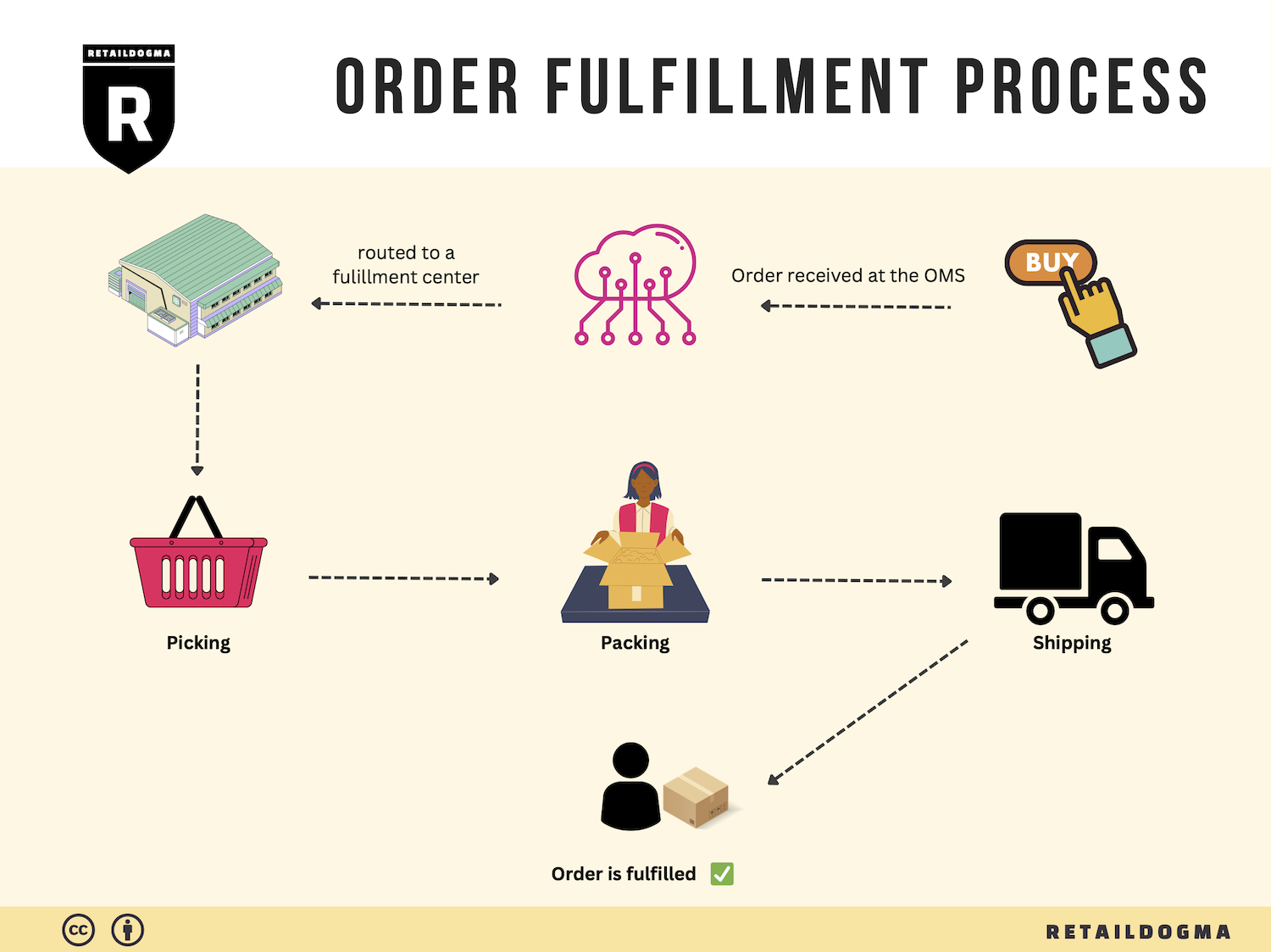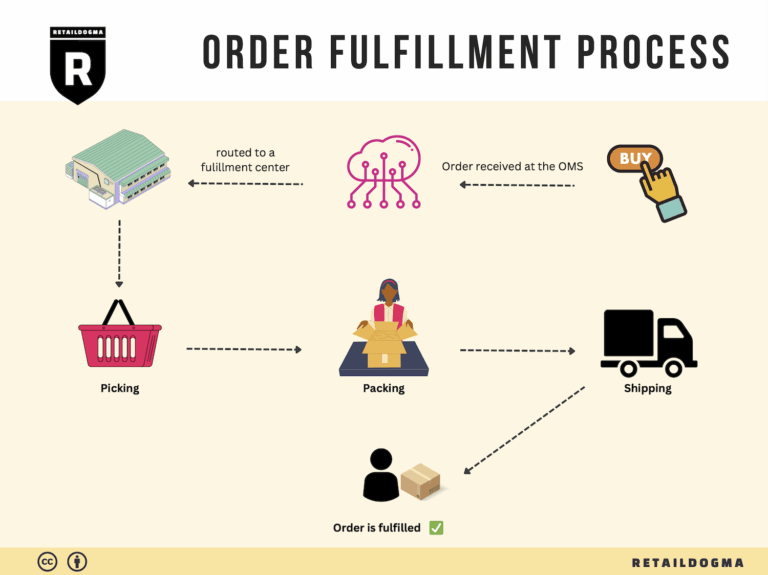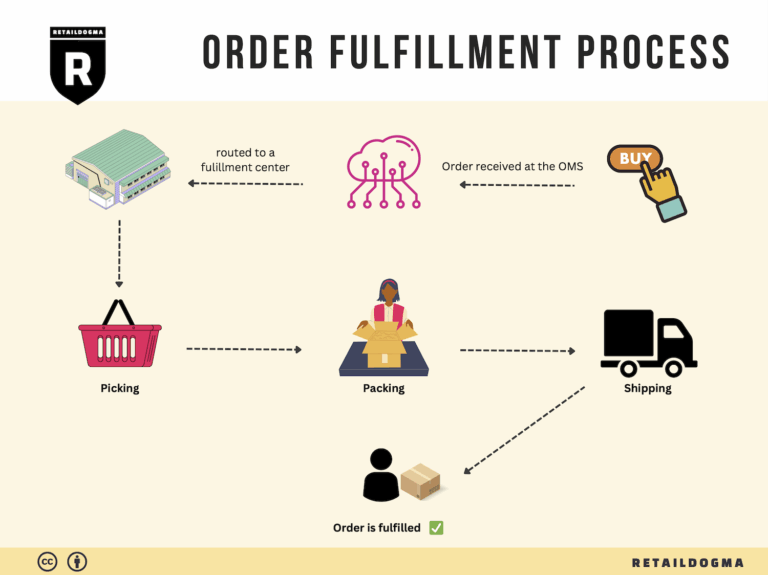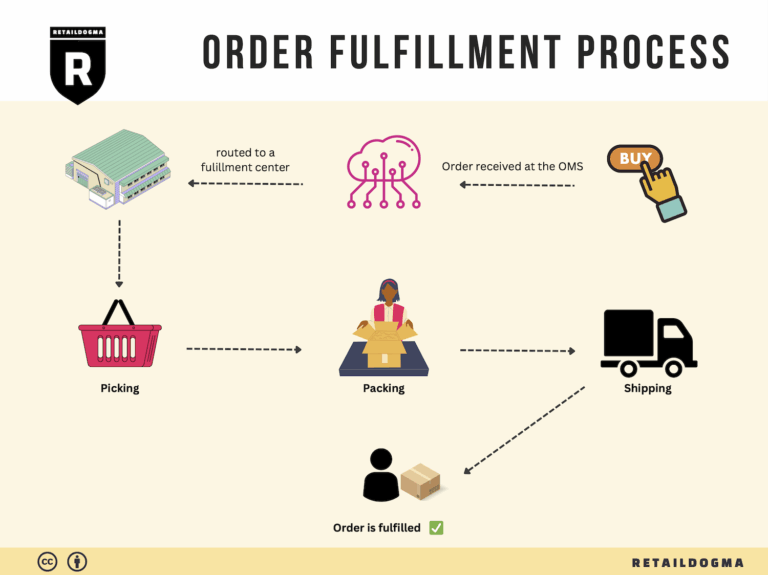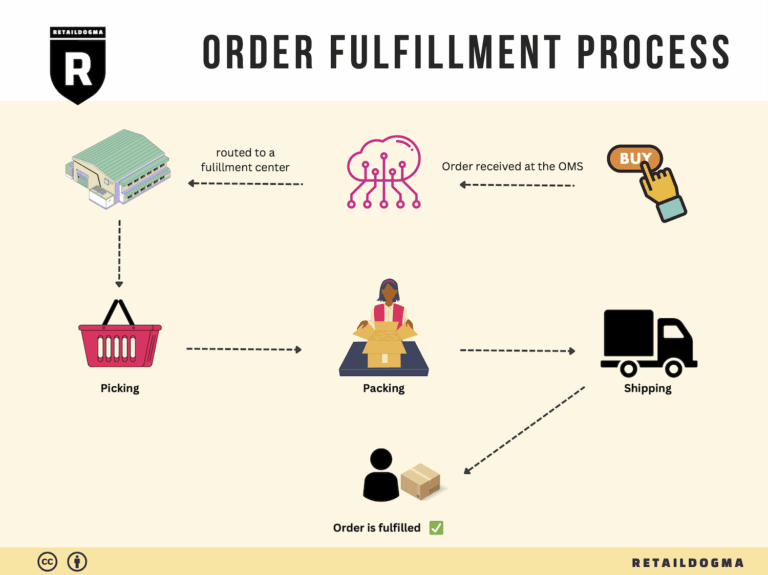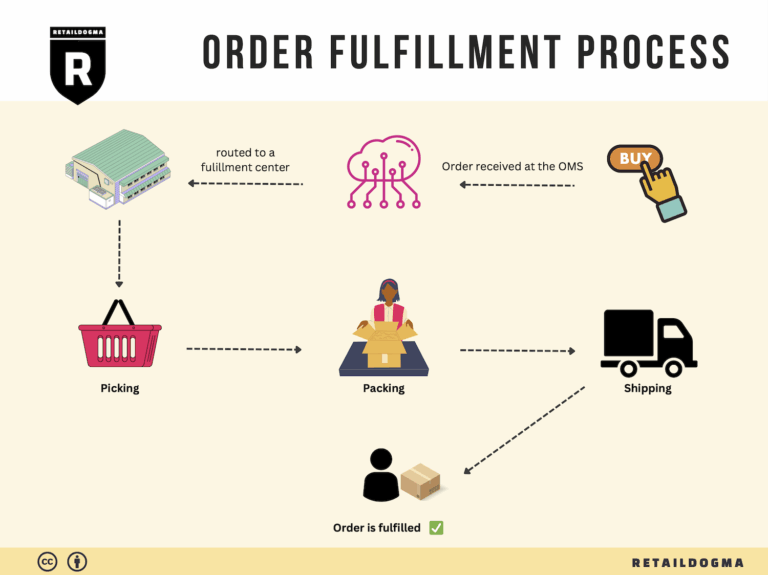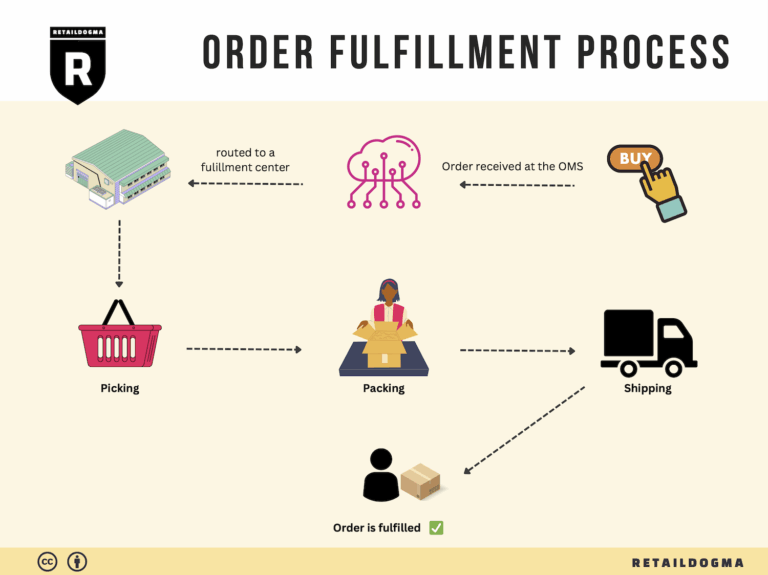Ecommerce Fulfillment Services: The Ultimate Guide (2025)
What is E-commerce Fulfillment? An Introduction for Growing Businesses
As your e-commerce business grows, managing the logistics of packing and shipping orders can quickly become overwhelming. The thrill of increased sales often collides with the complexities of order fulfillment, leading many entrepreneurs to feel stressed and stretched thin. This is where understanding e-commerce fulfillment becomes essential.
Understanding Fulfillment
At its core, fulfillment is the process of getting a product from your warehouse or inventory to your customer’s doorstep. This involves several critical steps: receiving inventory, storing products, picking and packing orders, and shipping them out. For many growing businesses, mastering this process is crucial not only for maintaining customer satisfaction but also for sustaining growth.
What This Guide Covers
In this guide, we will explore various fulfillment models available to e-commerce businesses, including Third-Party Logistics (3PL) and Fulfillment by Amazon (FBA). Each model has its advantages and challenges, and understanding them will help you make informed decisions tailored to your business needs.
We will dive into the core services provided by fulfillment partners, which may encompass inventory management, order processing, shipping solutions, and customer service. By grasping what each service entails, you can better evaluate potential partners and their offerings.
Choosing the right fulfillment partner is a significant decision that can impact your business’s efficiency and customer satisfaction. This guide will provide practical advice on how to assess potential partners based on your specific requirements, including factors like location, technology capabilities, and service levels.
Pricing is another critical aspect we’ll cover. Understanding the cost structure of fulfillment services is essential for budgeting and maximizing your profit margins. We’ll break down common pricing models and what factors influence costs, helping you to anticipate your expenses and plan accordingly.
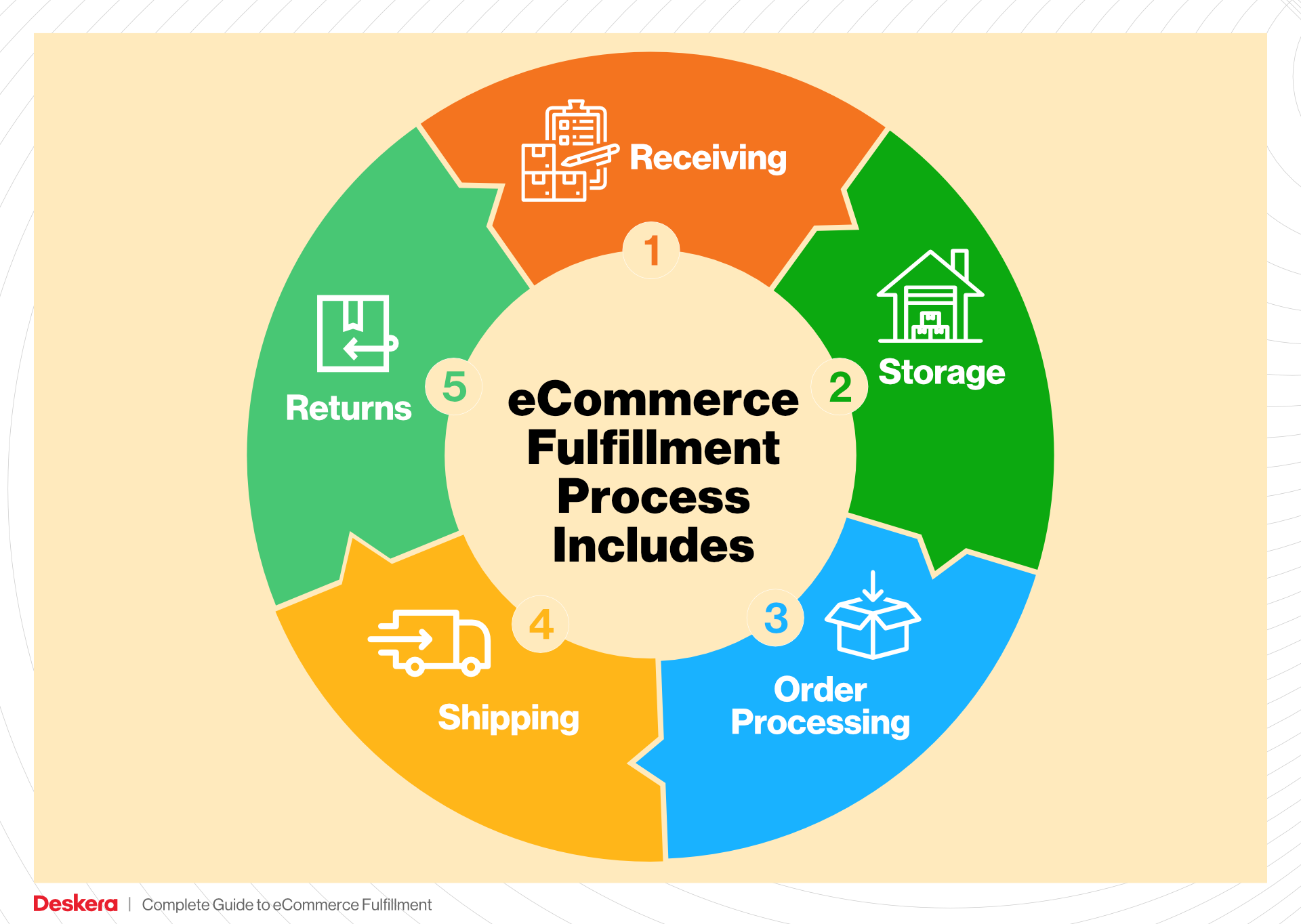
Empowering Your Business Decisions
The goal of this guide is to empower e-commerce business owners like you to make smart, informed decisions about your logistics strategy. By understanding the ins and outs of e-commerce fulfillment, you can streamline your operations, enhance customer satisfaction, and ultimately scale your business with confidence. As you navigate the complexities of fulfillment, remember that the right knowledge and partnerships can turn logistics from a headache into a competitive advantage.
What You’ll Learn In This Guide
- What is E-commerce Fulfillment? An Introduction for Growing Businesses
- The Order Fulfillment Process: From ‘Buy’ Button to Customer’s Door
- Comparing Fulfillment Models: In-House vs. 3PL vs. Dropshipping
- A Deep Dive into Amazon FBA: Pros, Cons, and Who It’s For
- Core Services Offered by Fulfillment Centers
- How to Choose a Fulfillment Partner: A 6-Point Checklist
- Understanding Fulfillment Pricing: A Breakdown of Common Fees
- Frequently Asked Questions (FAQs) about Fulfillment
- Conclusion: Is Outsourcing Fulfillment the Right Move for Your Business?
- Important Disclaimer
The Order Fulfillment Process: From ‘Buy’ Button to Customer’s Door
1. Receiving Inventory
The order fulfillment process begins with receiving inventory at the fulfillment center. When products arrive, they are unloaded, inspected, and sorted. This initial step is critical to ensure that the right products are received in the correct quantities and conditions.
During this phase, each item is assigned a Stock Keeping Unit (SKU), a unique identifier that helps streamline tracking and inventory management. Accurate receiving is vital because discrepancies can lead to stockouts or overstock situations, which can ultimately affect sales and customer satisfaction. An efficient receiving process also sets the tone for the rest of the fulfillment workflow, reducing errors and delays down the line.
2. Warehouse Storage
Once inventory is received, it is stored in designated areas within the fulfillment center. Effective warehouse storage strategies are essential for maximizing space and ensuring quick access to products. Items are often organized using a systematic approach, such as by category, size, or SKU.
This step is crucial for maintaining an organized inventory system, which reduces the time spent searching for items later. Key terms associated with warehouse storage include “bin locations” and “inventory turnover.” Bin locations refer to specific areas where products are stored, while inventory turnover measures how quickly inventory is sold and replaced, indicating the efficiency of storage practices. Properly managed storage systems lead to improved operational efficiency and enhanced customer service.
3. Order Picking
Order picking is the process of selecting products from the warehouse to fulfill customer orders. This is where efficiency can significantly impact delivery times and accuracy. Fulfillment centers often utilize various picking methods, such as batch picking, where multiple orders are picked simultaneously, or wave picking, which organizes picking based on shipping schedules.
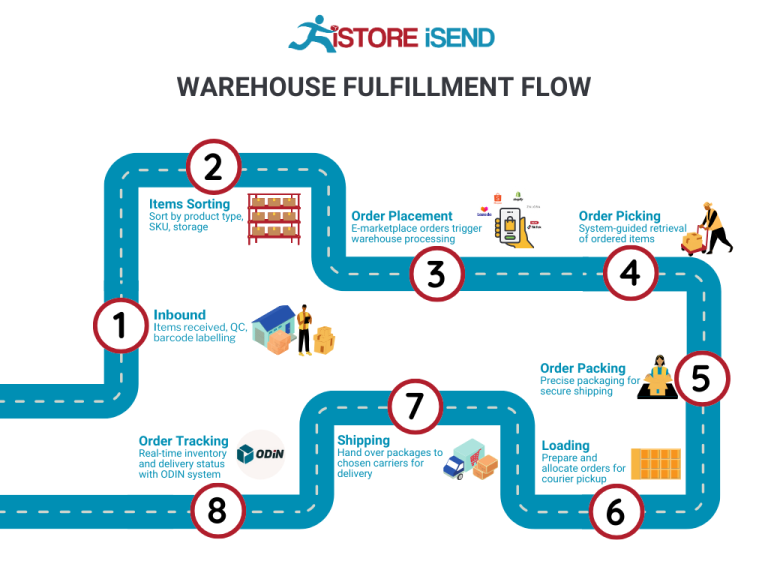
A key element in this step is the “pick list,” a document that outlines the items to be retrieved for each order. By streamlining the picking process and minimizing travel time within the warehouse, businesses can reduce labor costs and improve order accuracy. Effective order picking ensures that customers receive the correct items on time, fostering repeat business and customer loyalty.
4. Order Packing
After items are picked, they move to the packing station, where they are prepared for shipment. Packing involves checking items against the order to ensure accuracy, followed by safely packaging them to prevent damage during transit. This step is important not only for protecting the products but also for enhancing the unboxing experience for customers.
Key terms in this stage include “packaging materials” and “dimensional weight.” Packaging materials refer to boxes, bubble wrap, and other supplies used to secure items. Dimensional weight is a pricing technique used by carriers that takes into account the size of the package in addition to its weight. Efficient packing processes can reduce shipping costs and improve delivery times, contributing to a positive customer experience.
5. Shipping & Delivery
The final step in the order fulfillment process is shipping and delivery. Once the orders are packed, they are labeled and sorted for dispatch to the appropriate carriers. Timely shipping is critical for meeting customer expectations, especially in an era where fast delivery is highly valued.
During this phase, businesses must consider shipping methods, carrier partnerships, and tracking systems. A key term associated with this step is “last-mile delivery,” which refers to the final leg of the delivery journey from the distribution center to the customer’s doorstep. Effective shipping strategies not only ensure that products arrive on time but also provide customers with tracking information, enhancing transparency and trust in the purchasing process.
In conclusion, mastering the order fulfillment process—from receiving inventory to shipping and delivery—is crucial for e-commerce businesses looking to scale effectively. By optimizing each step and leveraging key terms and practices, businesses can improve operational efficiency, reduce costs, and elevate customer satisfaction, ultimately driving growth and success in the competitive e-commerce landscape.
Comparing Fulfillment Models: In-House vs. 3PL vs. Dropshipping
Fulfillment Model Comparison Table
| Model | Who Handles Inventory | Best For (Business Stage) | Key Advantage | Key Disadvantage |
|---|---|---|---|---|
| In-House Fulfillment | Business Owner | Established Businesses | Full control over inventory and processes | High upfront costs and operational complexity |
| Third-Party Logistics (3PL) | 3PL Provider | Growing Businesses | Scalable and cost-effective | Less control over inventory and processes |
| Dropshipping | Supplier | Startups / New Businesses | Low startup costs and minimal risk | Lower profit margins and reliance on suppliers |
In-House Fulfillment
In-house fulfillment involves managing all aspects of storage, packing, and shipping within your own facilities. This model is best suited for established businesses that have the necessary resources and infrastructure to handle fulfillment internally. The primary advantage of in-house fulfillment is the control it affords over inventory management, order processing, and customer experience. Businesses can tailor their operations to meet specific customer needs, maintain brand integrity, and implement quality control measures effectively. However, this model comes with significant disadvantages. The initial investment in warehouse space, equipment, and staffing can be substantial, and managing logistics can become operationally complex. As a business scales, maintaining efficiency and meeting increased order volumes can strain resources, leading to potential delays and increased costs.
Third-Party Logistics (3PL)
Third-party logistics (3PL) providers offer outsourced fulfillment services, handling inventory storage, order processing, and shipping on behalf of businesses. This model is particularly advantageous for growing businesses that need to scale quickly without the overhead of managing their own logistics. The key benefits of using a 3PL include flexibility and cost-effectiveness; businesses can easily adjust their logistics operations based on demand fluctuations, and they can leverage the 3PL’s existing infrastructure and expertise. Additionally, many 3PL providers have advanced technology and systems in place, allowing for better tracking and management of inventory. However, the trade-off is a decrease in control over inventory and the fulfillment process. Businesses may face challenges in communication and coordination with the 3PL, and there can be variability in service quality, which may impact the customer experience.
Dropshipping
Dropshipping is a fulfillment model where businesses sell products without holding any inventory. Instead, when a customer places an order, the business purchases the item from a third-party supplier who then ships it directly to the customer. This model is ideal for startups and new businesses that want to minimize financial risk and avoid the complexities of inventory management. The primary advantage of dropshipping is the low barrier to entry; entrepreneurs can start selling products with minimal investment in inventory and logistics. However, dropshipping also has its drawbacks. Profit margins tend to be lower compared to other fulfillment models, as suppliers often charge higher prices for their services. Furthermore, businesses become reliant on suppliers for product quality and shipping times, which can lead to customer dissatisfaction if not managed carefully. This lack of control can be detrimental, especially as the business scales and customer expectations rise.
Conclusion
Choosing the right fulfillment model is crucial for e-commerce success, particularly as businesses look to scale their operations. Each model—In-House, 3PL, and Dropshipping—offers unique advantages and disadvantages that can significantly impact operational efficiency, customer satisfaction, and overall profitability. Businesses must carefully consider their current stage of growth, resource availability, and long-term goals when determining the best fulfillment strategy. By aligning the chosen model with their operational capabilities and customer expectations, e-commerce business owners can position themselves for sustainable growth in a competitive marketplace.
A Deep Dive into Amazon FBA: Pros, Cons, and Who It’s For
Understanding Fulfillment by Amazon (FBA)
Fulfillment by Amazon (FBA) is a service that allows e-commerce sellers to store their products in Amazon’s fulfillment centers. Amazon takes care of storage, packaging, and shipping, while also handling customer service and returns for those products. This model provides sellers with a streamlined way to manage logistics, enabling them to focus on growing their businesses.
How FBA Works
-
Setup: Sellers begin by creating an Amazon Seller account and enrolling in the FBA program. They then send their inventory to Amazon’s fulfillment centers, such as those located in Orlando, FL.
-
Storage: Once Amazon receives the products, they are stored in their warehouses until sold. Sellers can monitor inventory levels through their Seller Central dashboard.
-
Order Fulfillment: When a customer places an order for a product fulfilled by Amazon, the fulfillment center picks, packs, and ships the product directly to the customer.
-
Customer Service: Amazon also manages customer inquiries and returns for FBA products, providing a layer of customer service that many sellers find beneficial.
-
Payment: After the sale, Amazon deducts fees for the FBA service from the seller’s account before depositing the remaining funds.
Pros of Fulfillment by Amazon (FBA)
1. Prime Eligibility
One of the most significant advantages of using FBA is the eligibility for Amazon Prime. Products fulfilled by Amazon can qualify for Prime, which provides sellers access to millions of Prime members who prefer fast, free shipping options. This can lead to higher sales volumes and increased visibility.
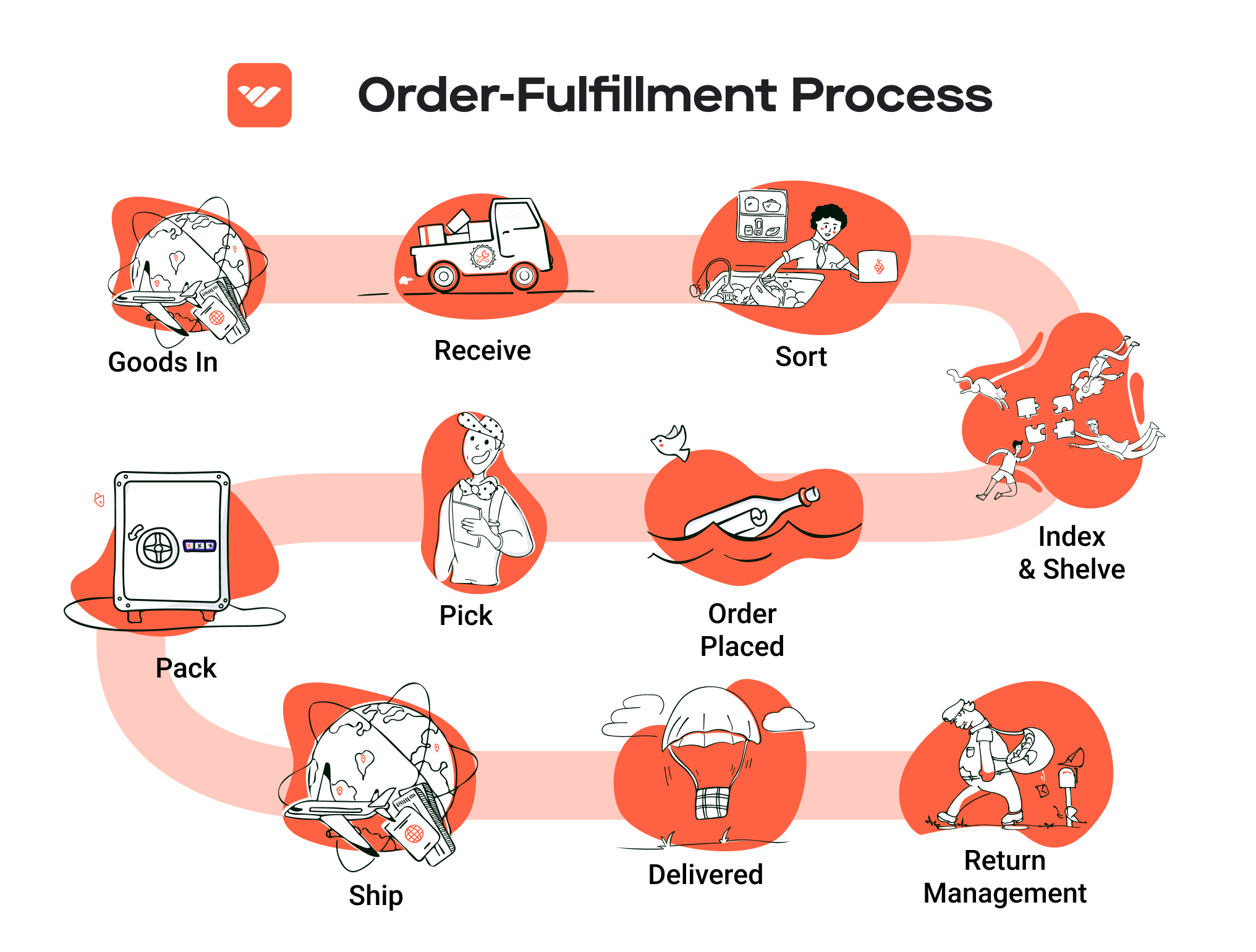
2. Customer Trust
Amazon has built a strong reputation for reliability and customer service. By utilizing FBA, sellers can leverage this trust, as customers often feel more comfortable purchasing items that are fulfilled by Amazon. This can result in higher conversion rates and repeat business.
3. Multi-Channel Fulfillment
FBA isn’t limited to sales on Amazon alone. Sellers can also use FBA to fulfill orders from other platforms, such as eBay or their own e-commerce sites. This flexibility allows sellers to centralize their logistics and inventory management.
4. Scalability
Using FBA allows businesses to scale without the need to invest heavily in their own warehousing and fulfillment infrastructure. As demand grows, sellers can easily send more inventory to Amazon’s fulfillment centers.
5. Enhanced Marketing Opportunities
FBA sellers can utilize various Amazon marketing tools, such as Sponsored Products, which can further enhance product visibility and sales.
Cons of Fulfillment by Amazon (FBA)
1. High Fees
While FBA can simplify logistics, it comes at a cost. Amazon charges various fees, including storage fees based on the amount of space your products occupy and fulfillment fees for each order shipped. For sellers with low margins, these fees can significantly cut into profits.
2. Strict Inventory Rules
Amazon enforces strict rules regarding inventory management. Sellers must adhere to guidelines about product condition, labeling, and packaging. Non-compliance can lead to additional fees or even account suspension.
3. Commingling Risks
FBA operates on a commingling model where products from different sellers are stored together. While this can streamline the fulfillment process, it also carries risks. If a customer receives a defective or counterfeit item, it can reflect poorly on the seller, even if they did not ship the problematic product.
4. Limited Control Over Fulfillment
Sellers relinquish a degree of control over their inventory and fulfillment process. This can be a concern for those who prefer to manage customer service and order fulfillment directly.
5. Inventory Management Challenges
Sellers must constantly monitor their inventory levels to avoid running out of stock or incurring long-term storage fees. This can be challenging, especially for seasonal or trending products.
Who is FBA Best For?
Fulfillment by Amazon is particularly well-suited for:
-
New E-commerce Entrepreneurs: Those just starting out can benefit from Amazon’s established infrastructure and customer trust, allowing them to focus on marketing and sales.
-
Growing Businesses: Companies looking to scale without investing in their own logistics will find FBA a practical solution to manage increased order volumes.
-
Sellers with Diverse Product Lines: Those with a wide array of products can leverage FBA to streamline their fulfillment process and simplify inventory management across multiple sales channels.
-
Businesses Targeting Prime Customers: Sellers who aim to capture the Prime customer base will find FBA essential for qualifying their products for this lucrative segment.
-
Brands Looking for Increased Visibility: Those wanting to enhance their marketing efforts on Amazon can leverage FBA’s benefits, such as eligibility for promotional campaigns.
In conclusion, while FBA offers numerous advantages that can facilitate growth and streamline operations, it is crucial for sellers to carefully evaluate the associated costs and risks. Understanding the FBA model will help e-commerce businesses make informed decisions about whether it aligns with their operational goals and growth strategies.
Core Services Offered by Fulfillment Centers
Inventory Management & Warehousing
Inventory management and warehousing are foundational services offered by fulfillment centers that enable e-commerce businesses to optimize their storage and stock control. Fulfillment centers, such as those operated by Amazon in Orlando, provide large-scale facilities equipped to handle diverse product ranges. This includes climate-controlled environments for sensitive items and advanced inventory tracking systems.
The benefits of efficient inventory management are manifold. First, it minimizes the risk of stockouts or overstock situations, both of which can lead to lost sales or increased holding costs. Advanced technologies, such as barcode scanning and RFID, allow for real-time tracking of inventory levels. This enables e-commerce businesses to make informed decisions about reordering and stock allocation, ultimately leading to improved cash flow and reduced operational costs.
Furthermore, strategic warehousing locations—like the Amazon Fulfillment Center in Lake Nona—enhance shipping efficiencies. Proximity to major transport hubs, such as Orlando International Airport, facilitates faster shipping options, which can significantly enhance customer satisfaction through expedited delivery.
Pick and Pack Services
Pick and pack services are critical in the fulfillment process, involving the selection of products from inventory and preparing them for shipment. Fulfillment centers streamline this process by employing trained staff and advanced technologies, such as automated picking systems and packing stations, to ensure accuracy and efficiency.
The primary benefit of pick and pack services is the enhanced speed of order fulfillment. E-commerce businesses can benefit from reduced lead times, allowing them to meet customer expectations for rapid delivery. Additionally, fulfillment centers often implement quality control measures during the pick and pack process to minimize errors, which reduces the likelihood of returns and enhances customer satisfaction.
Moreover, outsourcing pick and pack services allows e-commerce businesses to focus on core activities like marketing and product development rather than logistics. This strategic delegation enables companies to scale operations without the need for significant investment in warehousing and staffing.
Kitting and Assembly
Kitting and assembly services involve the grouping of various products into ready-to-ship kits or the assembly of products before shipping. Fulfillment centers are equipped to handle complex kitting tasks, which can include bundling items for promotional offers or assembling products that require multiple components.
The benefit of kitting and assembly services lies in their ability to enhance the customer experience. By providing pre-packaged kits, businesses can simplify the purchasing process for customers, which can lead to increased sales and higher average order values. This is particularly beneficial during promotional campaigns where bundled products can create compelling offers.
Additionally, these services can help e-commerce businesses reduce shipping costs by consolidating multiple items into a single package. This not only lowers shipping expenses but also minimizes the risk of damage during transit, ultimately leading to higher customer satisfaction.
Returns Management (Reverse Logistics)
Returns management, also known as reverse logistics, is a critical service offered by fulfillment centers that focuses on the handling of returned goods. A well-structured returns process is essential for e-commerce businesses, as customers increasingly expect hassle-free return policies. Fulfillment centers streamline this process by providing dedicated facilities and systems to manage returns efficiently.
The primary benefit of effective returns management is the enhancement of customer trust and loyalty. A smooth return process can encourage customers to make purchases with confidence, knowing they have the option to return items if they do not meet their expectations. This can lead to increased sales and repeat business.
Additionally, fulfillment centers can analyze return data to identify trends and issues related to product quality or customer satisfaction. This information is invaluable for e-commerce businesses looking to refine their product offerings and improve overall customer experience. Efficient handling of returns can also minimize costs associated with restocking and processing returned items, allowing businesses to recover value from unsold inventory.
In conclusion, the core services offered by fulfillment centers such as inventory management, pick and pack services, kitting and assembly, and returns management are essential for e-commerce businesses aiming to scale their operations. By leveraging these services, companies can enhance efficiency, reduce operational costs, and ultimately improve customer satisfaction, positioning themselves for sustainable growth in a competitive marketplace.
How to Choose a Fulfillment Partner: A 6-Point Checklist
Location & Warehouse Network
Choosing a fulfillment partner with the right location and warehouse network is crucial for ensuring timely deliveries and reducing shipping costs. The geographic positioning of warehouses can significantly affect your logistics efficiency, particularly if you serve customers across multiple regions.
Questions to Ask:
– Where are the fulfillment centers located in relation to my primary customer base?
– How many warehouses does the partner operate, and are they strategically placed?
– Can they support both domestic and international shipping needs?
– What is their average shipping time to key markets?
A partner with multiple warehouses closer to your customers can help minimize shipping times and costs, enhancing customer satisfaction and loyalty.
Technology & Integrations
In today’s fast-paced e-commerce environment, technology plays a vital role in the efficiency of order fulfillment. A good 3PL partner should offer robust technology solutions that integrate seamlessly with your e-commerce platform, inventory management systems, and customer relationship management tools.
Questions to Ask:
– What technology platforms do you use for inventory management and order processing?
– Can your systems integrate with my existing e-commerce platform (e.g., Shopify, Amazon, WooCommerce)?
– Do you provide real-time tracking and reporting capabilities?
– How do you ensure data security and compliance with regulations?
A partner with advanced technology can help streamline operations, reduce errors, and provide valuable insights into your supply chain performance.
Specializations (e.g., Cold Storage, Oversized Items)
Depending on your product offerings, it may be important to find a fulfillment partner that specializes in certain types of goods. Whether you need cold storage for perishables or handling for oversized items, ensure that the partner can accommodate your specific requirements.
Questions to Ask:
– Do you have specialized facilities for my type of products?
– What safety and handling measures do you have in place for sensitive items?
– Can you manage seasonal fluctuations in inventory for my specialized products?
– Are there any additional fees for handling specialty items?
Choosing a partner with the right specialization can mitigate risks and ensure that your products are stored and handled correctly.
Scalability & Capacity
As your business grows, your fulfillment needs will likely change. It’s essential to partner with a 3PL provider that can scale operations in line with your business growth without compromising service quality.
Questions to Ask:
– What is your current capacity, and how do you handle peak seasons?
– How quickly can you scale operations if my order volume increases?
– Do you have contingency plans in place for unexpected surges in demand?
– Can you provide flexible warehousing options as my needs evolve?
A scalable partner will enable you to focus on growing your business while ensuring that fulfillment processes remain efficient and effective.
Pricing and Contracts
Understanding the pricing structure and contract terms is vital to avoid unexpected costs that can erode your profit margins. A transparent pricing model will help you budget effectively and assess the overall value of the partnership.
Questions to Ask:
– What is included in your pricing structure (e.g., pick and pack fees, storage fees, shipping costs)?
– Are there any hidden fees I should be aware of?
– What are the terms of the contract, and is there flexibility for renegotiation?
– How do you handle pricing adjustments during contract renewals?
A clear understanding of pricing will help you make informed decisions and maintain profitability as you scale your operations.
Customer Support & Reviews
Effective customer support is a hallmark of a reliable fulfillment partner. Responsive communication and problem-solving capabilities can make a significant difference in your day-to-day operations.
Questions to Ask:
– What are your customer service hours, and how can I reach you?
– Do you provide a dedicated account manager for my business?
– Can you share references or case studies from similar businesses?
– How do you handle issues or complaints, and what is your escalation process?
Researching customer reviews and feedback can provide insights into the partner’s reliability and service quality. A strong support system will help you address challenges promptly and maintain a smooth operation.
Conclusion
Choosing the right fulfillment partner is a critical decision for e-commerce businesses aiming to scale. By carefully evaluating potential partners against this checklist, you can ensure that you select a provider that aligns with your operational needs and growth goals. Prioritize these factors to build a partnership that enhances your logistics efficiency, improves customer satisfaction, and supports your long-term success.
Understanding Fulfillment Pricing: A Breakdown of Common Fees
Initial Setup Fees
When engaging with a fulfillment center, the first expense you may encounter is the initial setup fee. This fee is typically charged to onboard your business to the fulfillment platform. It covers the costs associated with integrating your inventory management system with the fulfillment center’s technology. The setup fee may vary based on the complexity of your operations and the number of SKUs (Stock Keeping Units) you have.
For instance, if you have a large number of unique products, expect higher fees due to the time and resources required to establish your account and system integrations. Additionally, some fulfillment centers may offer tiered pricing based on your projected order volume, which can influence the initial setup costs. Always request a detailed breakdown of what the setup fee includes to avoid hidden charges.
Receiving Fees
Receiving fees are incurred when the fulfillment center receives and processes your inventory. This fee is generally calculated per pallet or per unit and covers the labor and equipment used to unload, inspect, and store your products.
For example, if you send a shipment of 100 pallets, you may be charged a set fee for each pallet received. Some centers may also charge additional fees for special handling, such as fragile items or products requiring temperature control. To minimize receiving fees, consolidate shipments and ensure your products are properly labeled and packaged to streamline the receiving process.
Storage Fees (per pallet/bin)
Storage fees are charged for the space your inventory occupies within the fulfillment center. This fee can be assessed on a monthly basis and is typically calculated per pallet or per bin. The rate may vary depending on the size of the item and the duration of storage.
Many fulfillment centers implement tiered pricing structures, where the rate decreases as you store larger quantities. This incentivizes businesses to maintain higher inventory levels, which can lead to lower per-unit storage costs. Additionally, be aware that some centers may impose additional fees for long-term storage if your products remain unsold for an extended period. To manage storage costs effectively, regularly review your inventory turnover rates and adjust your stock levels accordingly.
Pick & Pack Fees (per item/order)
Pick and pack fees are incurred each time an order is fulfilled. This fee covers the labor involved in retrieving items from storage, packing them, and preparing them for shipment. The calculation is typically based on the number of items in an order rather than a flat rate.
For instance, if a customer orders three items, the fulfillment center may charge a per-item fee for picking and packing each of those items. Some fulfillment centers may offer discounts for larger orders, so it’s beneficial to understand how your average order size impacts these costs. To optimize pick and pack fees, consider bundling products into kits or offering incentives for larger purchases, which can lead to cost savings on fulfillment.
Shipping Fees
Shipping fees are one of the most variable costs associated with fulfillment. These fees depend on several factors, including the destination, weight, and dimensions of the package. Fulfillment centers often have negotiated rates with shipping carriers, which can result in lower shipping costs for your business compared to standard retail rates.
Additionally, some fulfillment centers offer flat-rate shipping options for specific regions or order sizes. To get the most accurate shipping cost, provide the fulfillment center with detailed information about your products and typical order profiles. By doing so, they can offer you the best shipping options and rates available.
Conclusion and Tips for Accurate Quotes
Obtaining an accurate quote for fulfillment services is crucial for budgeting and financial planning. Here are a few tips to ensure you receive the most precise estimates:
-
Provide Detailed Information: Clearly outline your inventory types, expected order volumes, and specific needs (e.g., special handling, temperature control).
-
Ask for Itemized Quotes: Request a detailed breakdown of all potential fees, including any variable costs that may arise based on your business model.
-
Compare Multiple Providers: Don’t settle for the first quote. Compare offerings from various fulfillment centers to find the best combination of services and pricing.
-
Inquire About Discounts: Many fulfillment centers offer discounts for long-term contracts or higher volumes, so be sure to ask about potential savings.
-
Review Contracts Carefully: Before signing, read through the terms and conditions related to fees, service levels, and penalties for storage or handling to avoid unexpected costs.
By following these guidelines, you can effectively navigate the complexities of fulfillment pricing and choose a partner that aligns with your business goals.
Frequently Asked Questions (FAQs) about Fulfillment
1. What is an Amazon Fulfillment Center?
An Amazon Fulfillment Center is a large-scale warehouse designed specifically for storing, packing, and shipping products sold through Amazon’s online platform. These centers are equipped with advanced technology and logistics systems to ensure quick processing of orders, allowing for efficient delivery to customers.
2. Where is the Amazon Fulfillment Center located in Orlando?
The Amazon Fulfillment Center in Orlando is located at 12340 Boggy Creek Rd, Orlando, FL 32824, within the Lake Nona Airport Business Park. This strategic location facilitates efficient shipping and logistics due to its proximity to Orlando International Airport.
3. What services do Amazon Fulfillment Centers provide?
Amazon Fulfillment Centers provide a range of services, including inventory storage, order processing, packaging, and shipping. They also handle returns and customer service inquiries related to fulfillment, ensuring a seamless experience for both sellers and buyers.
4. How does Amazon’s fulfillment process work?
When a customer places an order on Amazon, the fulfillment process begins. The order is received by the fulfillment center, where the item is picked from inventory, packed into a box, and shipped out to the customer. Amazon utilizes sophisticated software to track inventory levels and streamline these operations for efficiency.
5. What is the difference between a warehouse and a fulfillment center?
A warehouse is primarily used for storage of goods, while a fulfillment center is focused on the entire order processing lifecycle, including picking, packing, and shipping products directly to customers. Fulfillment centers are equipped with technology and systems designed to speed up these processes.
6. What is a Third-Party Logistics Provider (3PL)?
A Third-Party Logistics Provider (3PL) is a service that allows businesses to outsource their logistics and fulfillment operations. This can include warehousing, order fulfillment, and shipping services. Companies often use 3PLs to scale their operations without investing heavily in infrastructure.
7. How much do fulfillment services cost?
Costs for fulfillment services can vary widely based on factors such as order volume, storage space, and the complexity of services required. Generally, businesses can expect to pay for storage fees, picking and packing fees, and shipping costs. It’s advisable to request quotes from multiple providers to find the best fit for your budget.
8. What are the benefits of using Amazon Fulfillment Centers for my e-commerce business?
Using Amazon Fulfillment Centers allows businesses to leverage Amazon’s extensive logistics network, ensuring faster delivery times and improved customer satisfaction. Additionally, sellers can benefit from Amazon’s customer service and return handling, freeing up resources to focus on other aspects of their business.
9. Can small businesses use Amazon Fulfillment Centers?
Yes, small businesses can utilize Amazon Fulfillment Centers through programs like Fulfilled by Amazon (FBA). This allows sellers of all sizes to take advantage of Amazon’s logistics capabilities, regardless of their operational scale.
10. What technology does Amazon use in its fulfillment centers?
Amazon employs a range of advanced technologies in its fulfillment centers, including robotics for picking and packing, automated sorting systems, and sophisticated inventory management software. These technologies help optimize efficiency, reduce errors, and speed up the fulfillment process.
Conclusion: Is Outsourcing Fulfillment the Right Move for Your Business?
Evaluating the Decision to Outsource Fulfillment
Outsourcing fulfillment can be a game-changer for e-commerce businesses looking to scale efficiently. By leveraging a fulfillment service, you can save valuable time and resources that would otherwise be spent on inventory management, packing, and shipping. This allows you to focus on core business activities such as marketing, product development, and customer service, ultimately driving growth.
Scalability is another significant advantage of utilizing a fulfillment partner. As your sales volume fluctuates, a capable fulfillment service can easily adjust to meet your changing needs. Whether you experience a seasonal surge or a steady increase in orders, a well-structured fulfillment operation can handle the logistics without compromising service quality. This flexibility is crucial for maintaining customer satisfaction and loyalty.
Moreover, partnering with an expert in fulfillment brings specialized knowledge and technology to the table. Fulfillment centers, like those in Orlando, are designed for efficiency and speed, equipped with advanced systems to ensure timely delivery and accurate inventory management. This expertise can help reduce shipping costs and improve delivery times, providing a competitive edge in the fast-paced e-commerce landscape.
However, the success of outsourcing fulfillment hinges on selecting the right partner. It’s essential to evaluate potential providers based on their capabilities, technology, and service offerings to ensure they align with your business goals.
To determine if outsourcing fulfillment is the right step for your business, conduct a thorough audit of your current shipping processes. Assess your pain points, costs, and service levels. This analysis will provide clarity on whether a fulfillment partner can help you achieve your growth objectives more effectively. Take action today to explore your options and make an informed decision that positions your business for success.
Important Disclaimer
⚠️ Important Disclaimer
The information in this guide is for educational purposes. Fulfillment services, pricing, and platform features change frequently. Always conduct your own due diligence and consult with providers directly before making business decisions.
